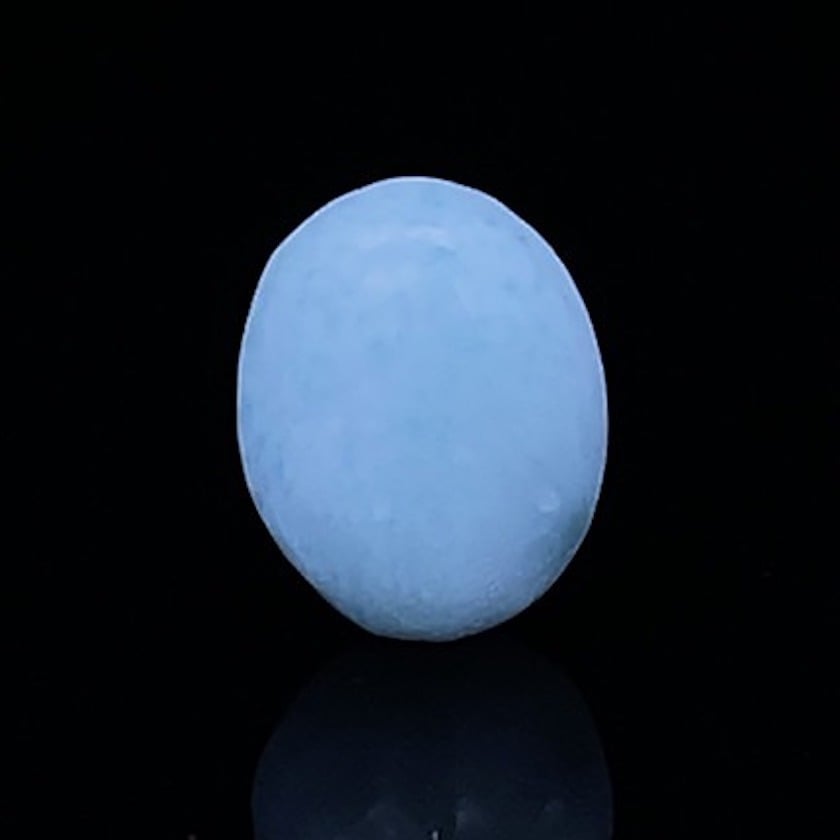Pectolite (Larimar) Value, Price, and Jewelry Information
Fibrous pectolite has long been a curiosity for gem collectors. Compact material can make wonderful cabochons, and transparent crystals are rare and usually tiny. Larimar, blue pectolite from the Dominican Republic, has become a popular jewelry stone.
2 Minute Read
Fibrous pectolite has long been a curiosity for gem collectors. Compact material can make wonderful cabochons, and transparent crystals are rare and usually tiny. In 1974, blue pectolite was found in the Dominican Republic. Known by the trade name Larimar, this blue gem has since become a popular jewelry stone.
Start an IGS Membership today
for full access to our price guide (updated monthly).Pectolite (Larimar) Value
Does Larimar Make a Good Jewelry Stone?
Although the inosilicate mineral pectolite occurs in locations across the globe, these fibrous aggregates are seldom cohesive enough to cut and usually too soft and fragile for jewelry wear. However, if pectolite's fibers grow intertwined, it can become jade-like in toughness as well as appearance. Known by the trade name Larimar, this variety of compact pectolite can take a very high polish. Though locally abundant, Larimar is a rare gem material.
Although pectolite stones of this type, especially Larimar, are relatively tough, their hardness range (from 4.5 to 6) makes them susceptible to scratches. Use protective settings for rings. Pectolite cabs make excellent stones for pendants and earrings.
What Color is Larimar?
With colors ranging from white to various shades of blue, pectolite from the Dominican Republic is the loveliest in the world. Traces of copper contribute to this blue coloration. The finest stones are dark blue and translucent, but sky-blue specimens with cloud-like patterns are also highly prized.
Identifying Larimar
The minerals pectolite and serandite form a series. Pectolite is the calcium (Ca) end member, while serandite is the manganese (Mn) end member.
Refractive Indices
The refractive indices (RI) of this series vary with the presence of Ca and Mn.
Phenomenal Effects
Fibrous material has chatoyancy that can give pectolite cabochons a cat's eye effect.
Luminescence
In longwave (LW) ultraviolet light:
- Orange-pink (Bergen Hill, New Jersey)
- Cream white (Lendalfoot, Scotland)
In shortwave (SW) ultraviolet light:
- Greenish yellow (Scotland)
- Yellowish, orange with green areas (Magnet Cove, Arkansas and Lake County, California)
- Faint yellow with phosphorescence (Paterson, New Jersey)
Are There Synthetic Pectolites?
Although no known pectolite synthetics exist, simulants have surfaced, such as ceramics and "Victoria Stone" and "Imori Stone" glass pieces. However, a gemological analysis can easily identify these.
Some Larimar gems may resemble turquoise or dyed howlite, and other compact pectolites may resemble jade. Again, these can usually be distinguished with standard tests.
There are no known common gem treatments for Larimar or other pectolite gems.
Where is Larimar Found?
The Dominican Republic is the principal source of gem-quality pectolite. Larimar is typically cabbed instead of faceted. Please note: Mindat reported on 9/1/2023 that the Filipinas Larimar Mine in the Dominican Republic is currently "closed for unknown reasons," per the Larimar Museum in Santo Domingo.
Sources of Other Gem-Quality Pectolites
In Canada, the Thetford Mines and Asbestos, Quebec produce magnificent, prismatic crystals. Indeed, these are the only sources of transparent, facetable pectolite, yielding twinned crystals up to 5″ long in colors ranging from white to pale blue-green.
In the United States, Alaska produces massive, jade-like stones (used as jade substitutes) as well as fine-grained, pale blue-green material. Magnet Cove, Arkansas yields pinkish manganiferous material. Lake County, California produces dense material suitable for cabochons. New Jersey has numerous sources, including the Paterson area (fine radial sprays), Bernards Township, Franklin, and Sterling Hill.
Other notable sources of pectolite include the following locations:
- Czech Republic; Greenland (manganiferous material); Japan; Morocco; Russia; South Africa; Sweden; Scotland, United Kingdom.
Stone Sizes
Lapidaries have cut cabochons up to a few inches from dense, massive, or fibrous material. In 1973, Asbestos, Quebec produced material for small gems, but only a few of these stones have been faceted in sizes up to approximately three carats.
How to Care for Larimar Jewelry
Popular jewelry stones, such as quartz, topaz, corundum, and diamond, will scratch pectolites, including Larimar gemstones. So, store your pectolite jewelry separately from such pieces.
Clean your pectolite gems and jewelry pieces with a soft brush, mild detergent, and warm water. Consult our gemstone jewelry cleaning guide for more recommendations.
Joel E. Arem, Ph.D., FGA
Dr. Joel E. Arem has more than 60 years of experience in the world of gems and minerals. After obtaining his Ph.D. in Mineralogy from Harvard University, he has published numerous books that are still among the most widely used references and guidebooks on crystals, gems and minerals in the world.
Co-founder and President of numerous organizations, Dr. Arem has enjoyed a lifelong career in mineralogy and gemology. He has been a Smithsonian scientist and Curator, a consultant to many well-known companies and institutions, and a prolific author and speaker. Although his main activities have been as a gem cutter and dealer, his focus has always been education. joelarem.com
International Gem Society
Related Articles
Black Diamond Value, Price, and Jewelry Information
Chameleon Diamond Value, Price, and Jewelry Information
Gray Diamond Value, Price, and Jewelry Information
Green Diamond Value, Price, and Jewelry Information
Latest Articles
Quartz Toxicity: Understanding the Risks for Jewelers and Wearers
Synthetic Amethyst: What is it and How is it Made?
Hambergite Value, Price, and Jewelry Information
Pearl Simulants: How to Spot Faux Pearls
Never Stop Learning
When you join the IGS community, you get trusted diamond & gemstone information when you need it.
Get Gemology Insights
Get started with the International Gem Society’s free guide to gemstone identification. Join our weekly newsletter & get a free copy of the Gem ID Checklist!
